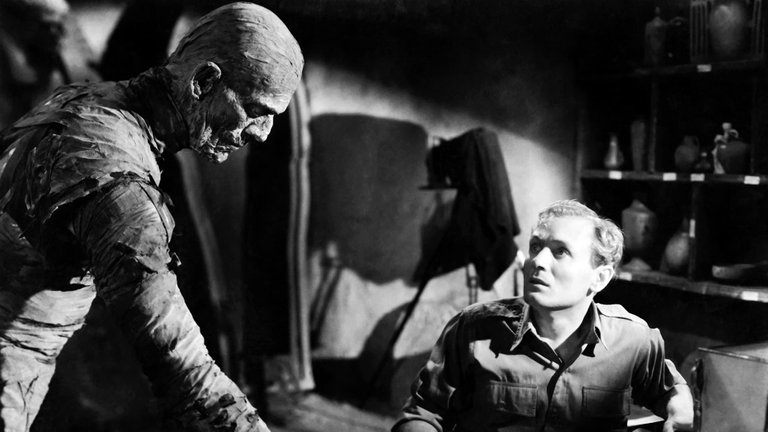Film Review: The Mummy (1932)

In 1931 Universal Pictures produced two horror films - Dracula and Frankenstein - that would become one of the most iconic works of the genre. Both films were adaptations of popular and well-established novels. That wasn’t the case with The Mummy, next title that which confirmed reputation of Universal as the studio specialised for horrors in Classic Hollywood. The film, directed by Karl Freund and released in 1932, was The Mummy, based on original script by John L. Balderston.
The plot begins in 1921 Egypt when British archaeological expedition led by Sir Joseph Wemple (played by Arthur Byron) discovers ancient artefacts, including the mummy of the priest Imhotep buried together with the Scroll of Toth, which, according to myth, had been used by goddess Isis to resurrect god Osiris. The scroll is held in the a box with hieroglyphs warning about curse against anyone that opens it. Dr. Muller (played by Edward Van Sloan), expert for the occult, warns Wemple about it, but while they are both gone, Wemple’s young assistant Ralph Norton (played by Bramwell Fletcher) succumbs to curiosity, opens the box and reads the scroll. As a result, the mummy is resurrected and goes away, while Norton goes mad. Ten years later, Wemple’s son Frank (played by David Manners) is leading another expedition, which, with the help of mysterious and sinister-looking Ardeth Bey (played by Boris Karloff), discovers the tomb and mummy of ancient Egyptian princess Ank-essen-amun. The mummy is brought to Cairo Museum. In the meantime, Bey meets Helen Grosvenor (played by Zita Johann), daughter of British governor of Sudan whose mother was Egyptian. Grosvenor also meets and falls in love with Frank, but that complicates matters, because Bey, who possesses hypnotic abilities, has certain sinister plans with her.
Balderston’s script took inspiration with Howard Carter’s famous discovery of Tutankhamun’s tomb in 1922, which had sparked great interest in anything related to Ancient Egypt, as well as urban legends about Curse of the Pharaoh. In order to provide basis for plot Balderston has mixed history and myth, embellishing with fiction in order to create additional melodrama. For example, title character of Imhotep is described as high priest who lived at the time of Amenhotep (Amenophis) the Great in late 14th Century BC, while the historic figure of Imhotep, famous architect and healer, has lived almost a thousand years earlier. Balderstone, however, dealt not only with history but some contemporary issues and few characters in the film discuss the ethics of archaeology or whether the discovered ancient treasures should be simply plundered or studied for scientific purposes.
Those details mattered little to most of the audience, which was probably very impressed by another display of Hollywood film making at its best. Direction was given to Karl Freund, German cinematographer who famous for his work on Metropolis and Dracula. He did a splendid job, carefully mixing studio sets, desert locations of Califiornia and stock documentary footage to make very good impression of Egypt. Even better was very effective flashback scene that shows Imhotep’s life in Ancient Egypt and explains the causes of his predicament. There is even some original music by James Dietrich which enhances suspense and melodrama, a detail that was missing in Dracula and Frankenstein.
The biggest asset of the film is Boris Karloff, gaunt and tall actor who, shortly after portraying the Monster in Frankenstein, again brought another iconic horror character to the screen. Interestingly enough, Karloff’s incarnation of Imhotep as mummy under wraps appears only at the beginning of the film, but it leaves great impression. Karloff is nevertheless effective as seemingly polite but ultimately menacing Ardeth Bey and the audience will be impressed after hearing grand actor talk. Zita Johann, actress who, coincidentally believed in reincarnation in real life, is quite effective in the role of exotic beauty menaced by forces beyond her comprehension. The rest of the cast isn’t that impressive, with exception of Edward Van Sloan, who like in Dracula and Frankenstein provides character that serves as voice of reason.
Like with many classic horror films, today’s audience probably won’t see it as a horror. Apart from truly suspenseful scene at the beginning, there isn’t anything particularly terrifying in the film. There is very small body count and almost all the violence takes place off screen. The Mummy, with its somewhat complicated plot dealing with reincarnation, lost love and resurrection, works better as a melodrama. The Mummy nevertheless delivered what audience wanted and became a big hit. Contrary to popular belief, it didn’t lead to a film series, at least not initially. The Mummy’s Hand, produced by Universal in 1940, had different title character played by Lon Chaney Jr., later receiving three more sequels. Freund’s film was actually remade in 1999 as The Mummy, launching the series starring Brendan Fraser and creating new franchise that involved spin-off films about Scorpio King.
RATING: 7/10 (+++)
Blog in Croatian https://draxblog.com
Blog in English https://draxreview.wordpress.com/
Leofinance blog https://leofinance.io/@drax.leo
Unstoppable Domains: https://unstoppabledomains.com/?ref=3fc23fc42c1b417
Hiveonboard: https://hiveonboard.com?ref=drax
Bitcoin Lightning HIVE donations: https://v4v.app/v1/lnurlp/qrcode/drax
Rising Star game: https://www.risingstargame.com?referrer=drax
1Inch: https://1inch.exchange/#/r/0x83823d8CCB74F828148258BB4457642124b1328e
BTC donations: 1EWxiMiP6iiG9rger3NuUSd6HByaxQWafG
ETH donations: 0xB305F144323b99e6f8b1d66f5D7DE78B498C32A7
